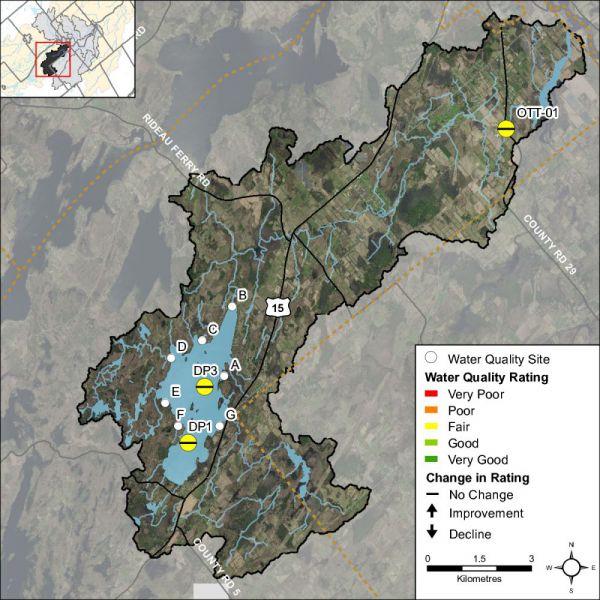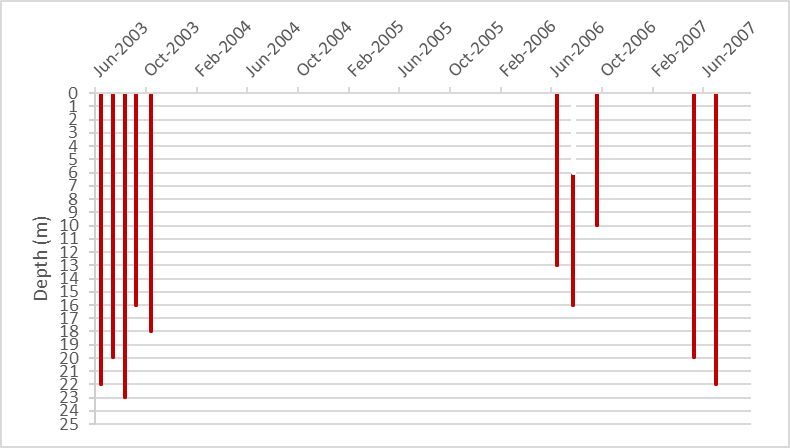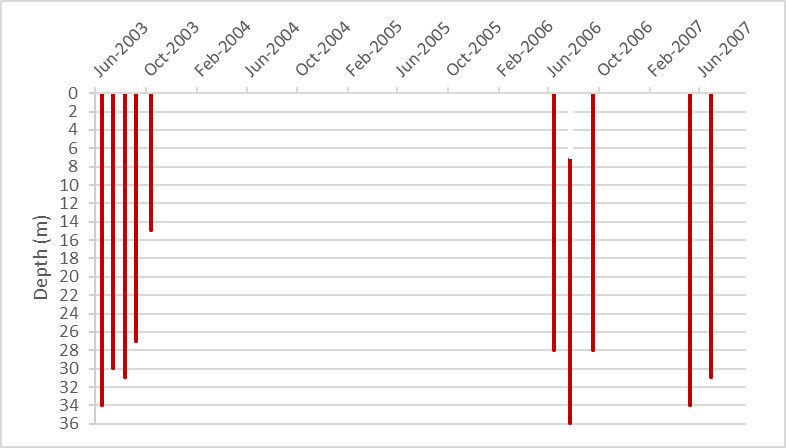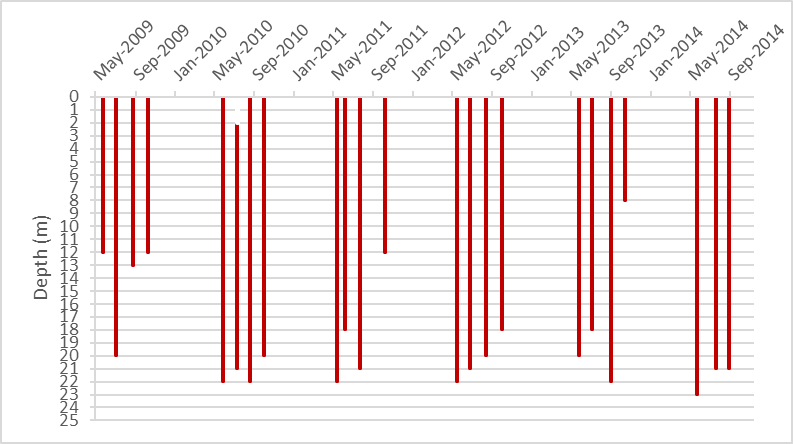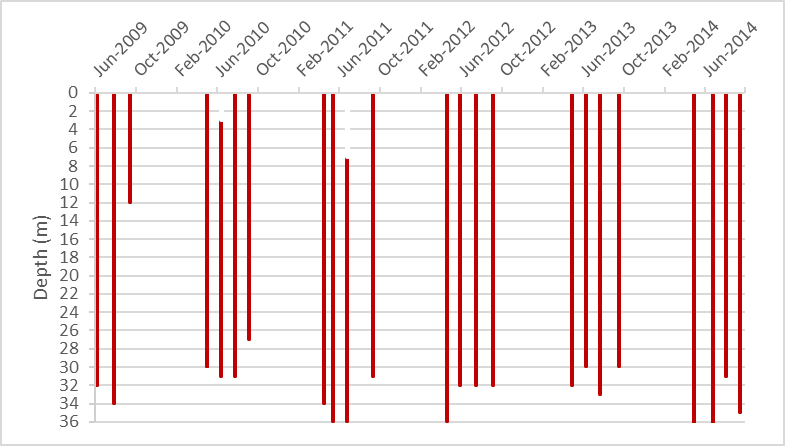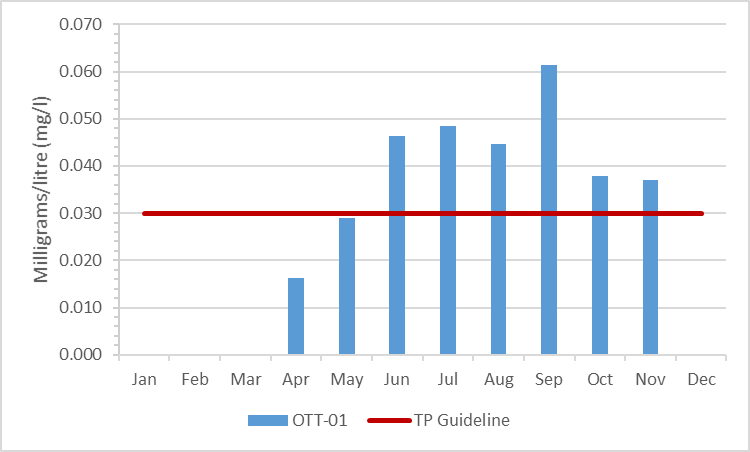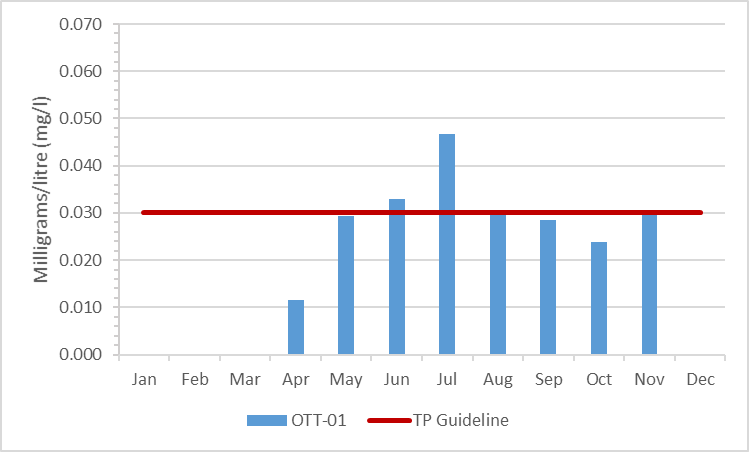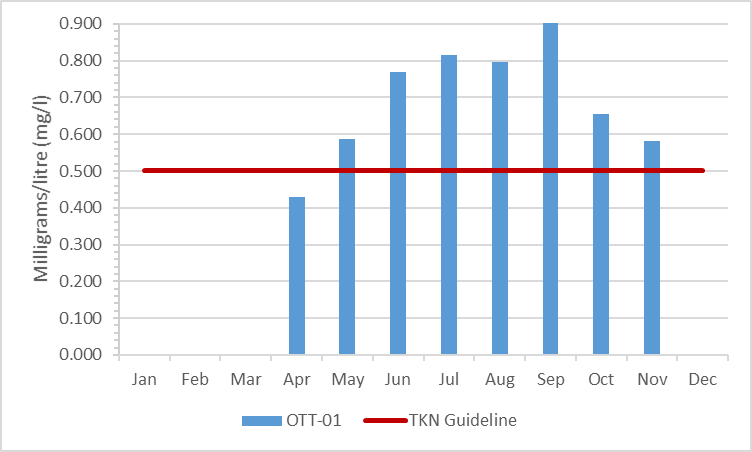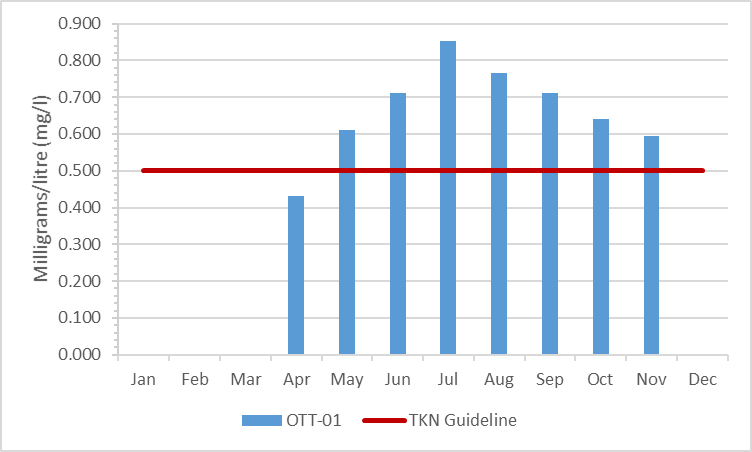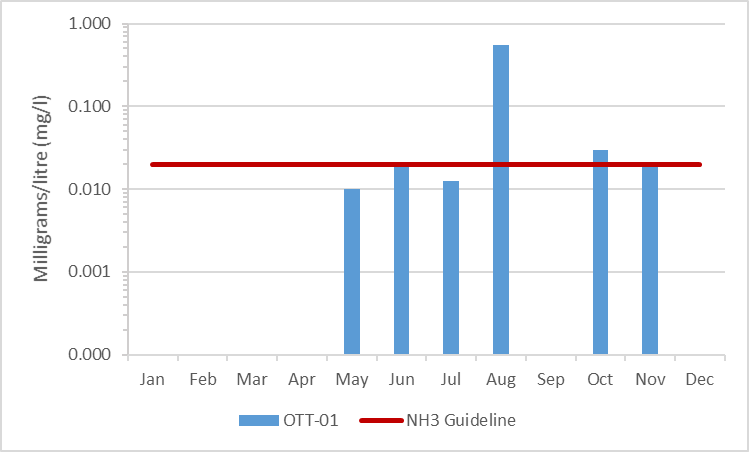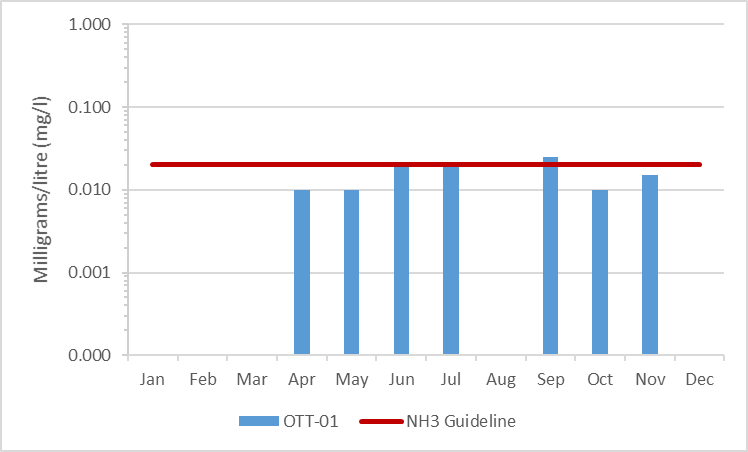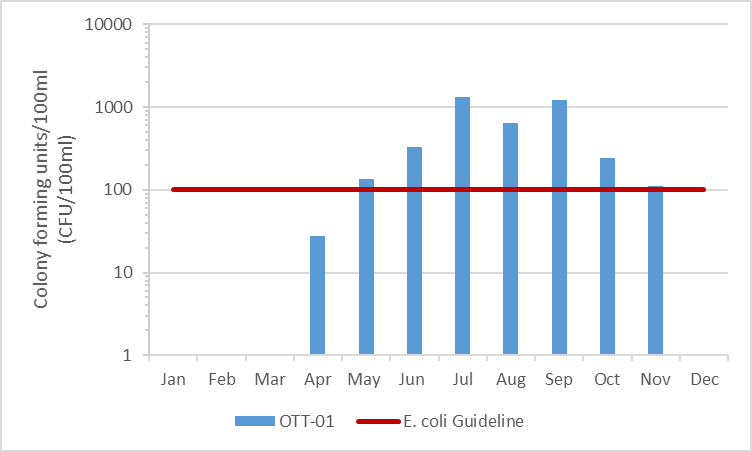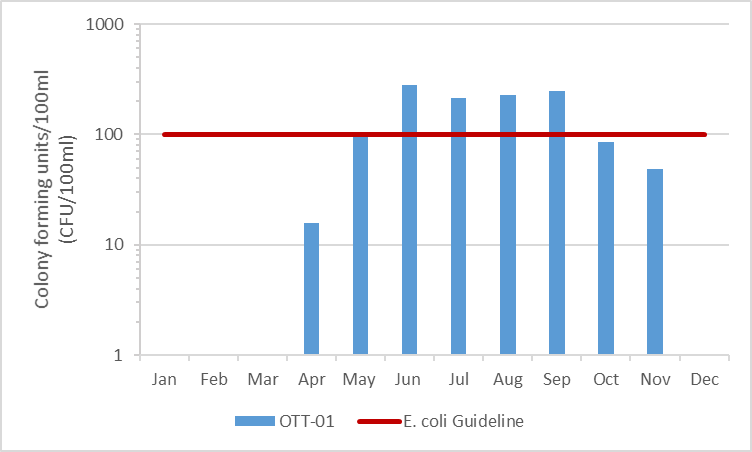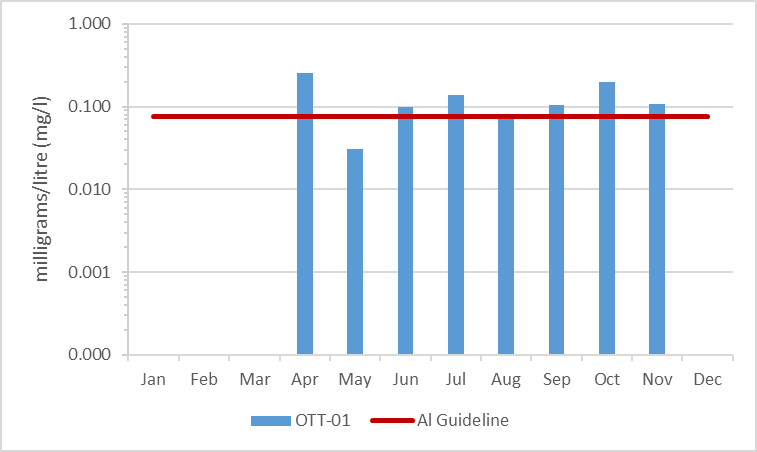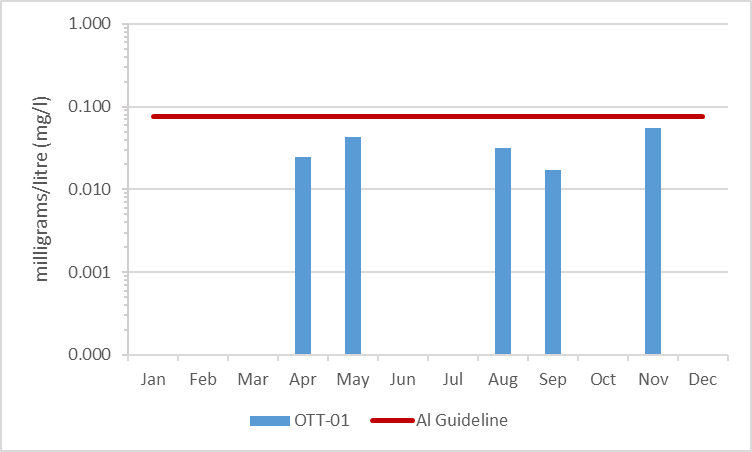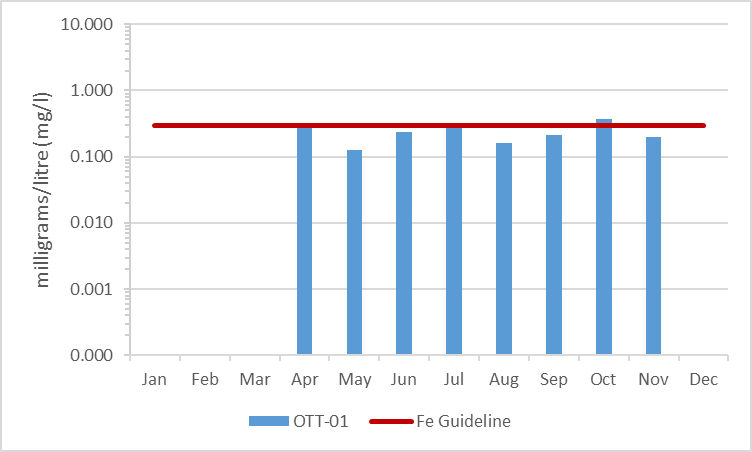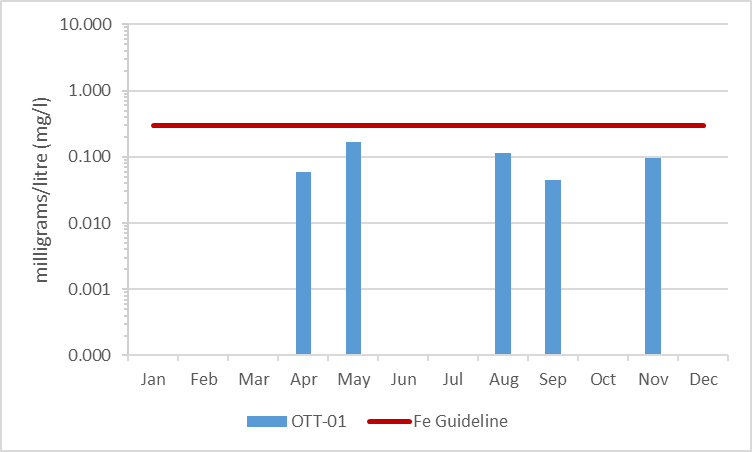2. Surface Water Quality Conditions
Surface water quality conditions in the Otter Lake and Creek catchment are monitored by the Rideau Valley Conservation Authority’s (RVCA) Watershed Watch Program and Baseline Water Quality Monitoring Program. Watershed Watch monitors watershed lakes to assess nutrient concentrations, water clarity, dissolved oxygen availability and pH. The baseline water quality program focuses on streams; data is collected for 22 parameters including nutrients (total phosphorus, total Kjeldahl nitrogen and ammonia), E. coli, metals (like aluminum and copper) and additional chemical/physical parameters (such as alkalinity, chlorides, pH and total suspended solids). Figure 1 shows the locations of monitoring sites in the catchment.
Otter Lake and Creek Water Quality
Water Quality Rating
The water quality rating for Otter Lake and Otter Creek (OTT-01) is “Fair” (Table 1) as determined by the Canadian Council of Ministers of the Environment (CCME) Water Quality Index. A "Fair" rating indicates that water quality is usually protected but is occasionally threatened or impaired; conditions sometimes depart from natural or desirable levels. Each parameter is evaluated against established guidelines to determine water quality conditions. Those parameters that frequently exceed guidelines are presented below. Analysis of the data has been broken into two periods; 2003 to 2008 and 2009 to 2014 to examine if conditions have changed between these periods. Table 1 shows the overall rating for the monitored surface water quality sites within the Otter Creek catchment and Table 2 outlines the Water Quality Index (WQI) scores and their corresponding ratings. It should be noted that Otter Lake WQI stayed within the Fair rating range, however the score dropped from 77 to 65, which is the lowest rating in that category before moving to a poor rating.
| Sampling Site | Location | 2003-2008 | Rating |
|---|---|---|---|
| RVL-26 | Otter Lake (2 deep water sites) | 77 | Fair |
| OTT-01 | Otter Creek at Highway 29 | 66 | Fair |
| Sampling Site | Location | 2009-2014 | Rating |
| RVL-26 | Otter Lake (2 deep water sites) | 65 | Fair |
| OTT-01 | Otter Creek at Highway 29 | 74 | Fair |
| Rating | Index Score |
|---|---|
| Very Good (Excellent) | 95-100 |
| Good | 80-94 |
| Fair | 65-79 |
| Poor (Marginal) | 45-64 |
| Very Poor (Poor) | 0-44 |
2) a. Otter Lake Water Quality
Surface water quality conditions in Otter Lake (RVL-26) have been monitored by RVCA’s Watershed Watch Program since 2003. Data from two deep point sites have been used to calculate the WQI rating for Otter Lake, which was determined to be “Fair” (Table 1). Moderate nutrient concentrations, good oxygen availability, clear water and occasionally elevated pH levels contributed to the rating. The following discussion explains how each of the monitored water quality parameters contributes to the lake’s water quality.
This report also considers data from seven additional shoreline sites that are monitored around the lake. These sites have not been included in the calculation of the CCME WQI rating, as they are not monitored with the same frequency as deep point sites. However, they do provide important information on water quality conditions in the near shore areas. For locations of shoreline sites please see Figure 1.
The 2003 Otter Lake State of the Lake Environment Report (Rideau Valley Conservation Authority, 2005) noted that Otter Lake had a moderate concentration of nutrients, generally suitable fish habitat conditions and good water clarity. The data presented in this report indicates that this continues to be the case and that a proactive cautionary program of best management practices is important to ensure the protection of the lake environment.
Nutrients
Total phosphorus (TP) is used as a primary indicator of excessive nutrient loading and contributes to abundant aquatic vegetation growth and depleted dissolved oxygen levels. The Provincial Water Quality Objective (PWQO) is used as the TP Guideline and states that in lakes, concentrations greater than 0.020 mg/l indicate an excessive amount of TP within the water column.
Total Kjeldahl nitrogen (TKN) is used as a secondary indicator of nutrient loading. RVCA uses a guideline of 0.500 mg/l to assess TKN[1] within surface waters.
At the Deep Points
TP and TKN sampling results are presented in Figures 2 to 5. In the 2003 to 2008 period, 100 percent of samples analyzed for TP were less than the TP guideline and stayed fairly consistent at 97 percent in the 2009 to 2014 period. The average TP concentration slightly increased from 0.009 mg/l to 0.010 mg/l. TKN concentrations were fairly normal with 97 percent of reported results below the TKN guideline in the first period (2003-2008); this decreased to 89 percent of samples in the 2009 to 2014 period. The average TKN concentration declined from 0.411 mg/l to 0.404 mg/l (Table 3).
| Total Phosphorous 2003-2008 | |||
|---|---|---|---|
| Site | Average (mg/l) | Below Guideline | No. Samples |
| RVL-26 | 0.009 | 100% | 34 |
| Total Phosphorous 2009-2014 | |||
| Site | Average (mg/l) | Below Guideline | No. Samples |
| RVL-26 | 0.01 | 93% | 34 |
| Total Kjeldahl Nitrogen 2003-2008 | |||
| Site | Average (mg/l) | Below Guideline | No. Samples |
| RVL-26 | 0.411 | 97% | 34 |
| Total Kjeldahl Nitrogen 2009-2014 | |||
| Site | Average (mg/l) | Below Guideline | No. Samples |
| RVL-26 | 0.404 | 89% | 46 |
Average year to year concentrations have varied for both TP and TKN (Figures 6-9) from 2003-2008 and 2009-2014. An increase in average concentrations from 2008 to 2013 is visible, however all average TP and TKN results are below the guidelines in both monitoring periods (2003-2008 and 2009-2014). Overall, the data presented indicates that nutrient concentrations may be considered moderate in the mid-lake, deep water sites on Otter Lake.
Around the Lake
The average nutrient concentrations at monitored shoreline sites around the lake vary from year to year (Figures 10-13). Please note that in the 2003-2008 monitoring period, sites were not sampled in 2004 and 2005. Sites B, C and F were sampled in 2003, 2006, 2007 and 2008 while sites A, D, E and G were only sampled in 2003 and 2008. In the second monitoring period (2009-2014) sites B, C and F were sampled every year, while sites A, D, E and G were sampled every fifth year.
Average total phosphorous concentrations are below the TP guideline at all sites in both monitoring periods (Figures 10 and 11), indicating nutrient enrichment does not to appear to be a problem in the monitored near shore areas.
TKN concentrations were also below the guideline at monitored sites; with the exception in 2013 at sites C and F which showed TKN concentrations above the guideline. Nutrient enrichment does not appear to be a problem in the monitored shoreline sites on Otter Lake (Figures 12 and 13).
Summary
Otter Lake nutrient concentrations are generally below the guidelines, with few exceedances. Average TP and TKN results (Table 3) are comparable to the 2003 Otter Lake State of the Lake Environment Report (Rideau Valley Conservation Authority, 2005) with TP concentrations of about .010 mg/l and TKN concentrations of about .445 mg/l.
Efforts such as the diversion of runoff and enhanced shoreline buffers are important to continue to protect and enhance water quality and reduce future nutrient exceedances. Nutrient exceedances may be partially attributed to the natural aging of a lake and basin characteristics. All residents can help reduce their impact on the lake by reducing nutrient inputs through practices such as proper maintenance of septic systems, keeping shorelines natural and using phosphate free soaps and detergents.
Water Clarity
Water clarity is measured using a Secchi disk during each deep point sample. Table 4 summarizes the recorded depths and shows that all readings have exceeded the minimum PWQO of 2 metres indicating that algae in the water column is not at excessive levels (good water clarity). Less than 2 m will indicate overproduction in a lake. The average Secchi depth increased from 5.8 metres (2003- 2008) to 6.4 metres (2009-2014). Figures 14 and 15 show that no individual reading has been below the guideline and measured depths range from 3.5 metres (Figure 15) to 12.5 metres (Figure 15). It should be noted that Secchi depths in many waterbodies have been influenced by the colonization of zebra mussels resulting in clearer waters than may have been seen prior to the introduction of this species; zebra mussels have been reported in Otter Lake since 2001.
| Secchi Depth 2003-2008 | |||
|---|---|---|---|
| Site | Average | Above Guideline | No. Samples |
| RVL-26 | 5.8 | 100% | 32 |
| Secchi Depth 2009-2014 | |||
| Site | Average | Above Guideline | No. Samples |
| RVL-26 | 6.4 | 100% | 43 |
Summary
Waters on Otter Lake are very clear and sufficient sunlight is able to penetrate the water column to support aquatic life and provide sufficient visibility for safe recreational use (boating, swimming). The 2003 Otter Lake State of the Lake Environment Report (Rideau Valley Conservation Authority, 2005) reported Secchi depths between 2.7 and 5.6 metres. The increase in water clarity can likely be attributed to the establishment of zebra mussels found in Otter Lake.
Fish Habitat
Two other factors, dissolved oxygen/temperature and pH were also assessed to provide an overall sense of the health of Otter Lake from a fish habitat perspective.
Dissolved Oxygen and Temperature
The red bars in Figures 16-19 show the depths where suitable conditions exist for cool water fish species (temperature less than 25°C and dissolved oxygen greater than 4 mg/l) at the monitored deep point sites (RVL-26DP1 and RVL-26DP3). The vertical axis represents the total lake depth at each site where the profile is taken. Suitable habitat conditions increased over the two time periods from an average of 21.5 metres at RVL-26DP1 (Figure 16) in 2003-2008 period to 24.1 metres (Figure 18) in the 2009-2014 period. Deep point site RVL-26DP3 increased from and 21.9 metres (Figure 17) in 2003-2008 period to 24.9 metres (Figure 19) in the 2009-2014 monitoring period.
pH
pH is a basic water quality parameter used to assess the acidity of water, an important factor for aquatic life. Figures 20 and 21 show pH concentrations in Otter Lake while Figures 22 and 23 summarize average concentrations by year.
The majority of samples for both time periods were within guidelines established by the PWQO which state that pH should be between 6.5 and 8.5 to protect aquatic life and prevent irritation for anyone using the waters for recreational purposes (Table 5). Average results border on the upper limit of the guideline and there was very little change between both monitoring periods indicating that elevated pH is a feature of this lake. Surface water’s that are found to be more alkaline (higher pH) can generally be attributed to the geology rather than anthropogenic activities. Biological activities such as photosynthesis may also affect pH.
| pH 2003-2008 | |||
|---|---|---|---|
| Site | Average | Within Guideline | No. Samples |
| RVL 26 | 8.4 | 75% | 28 |
| pH 2009-2014 | |||
| Site | Average | Within Guideline | No. Samples |
| RVL-26 | 8.3 | 76% | 46 |
Summary
Overall the water chemistry data at the deep point describes suitable habitat conditions for warm water fish species such as yellow perch, walleye and pike. There is some evidence that the warming of the water column in the late summer/fall may limit the amount of habitat for some sensitive species. pH conditions are typically on the upper end of the range recommended for the protection of aquatic life. Overall, the data indicates a healthy environment for aquatic species.
E. Coli
E. coli is sampled at monitored shoreline sites twice each sampling season. E. coli data was not used in the calculations of the WQI rating for the lake due to differences in sampling frequency and site locations. In both monitoring periods (2003-2008 and 2009-2014) all samples were below the E. coli guideline of 100 colony forming units (CFU) per 100 ml set by the PWQO. Across the lake for both monitoring periods the count at the geometric mean[2] was only 2 CFU/100ml (Table 6).
| E. Coli 2003-2008 | |||
|---|---|---|---|
| Site | Geometric Mean (CFU/100ml) | Below Guideline | No. Samples |
| RVL-26 | 2 | 100% | 20 |
| E. Coli 2009-2014 | |||
| Site | Geometric Mean (CFU/100ml) | Below Guideline | No. Samples |
| RVL-26 | 2 | 100% | 21 |
Figures 24 and 25 show the distribution of counts across all shoreline sites. All sites fall well below the guideline of 100 CFU/100ml. This is consistent with E. coli results from the 2003 Otter Lake State of the Lake Environment Report (Rideau Valley Conservation Authority, 2005) that indicated an average of 2.5 CFU/100ml.
Summary
The results presented above provide evidence that bacterial contamination is not a significant concern in Otter Lake and the water should be safe for recreational use such as swimming and boating.
2) b. Otter Creek Water Quality
There is one stream site on Otter Creek monitored in the Otter Lake and Creek catchment (OTT-01, Figure 1). Analysis of the data has been broken into two periods, 2003-2008 and 2009-2014, to examine if conditions have changed within this timeframe. Water quality at this site is reported as “Fair” (Table 1). The score at this site is largely influenced by elevated nutrient concentrations, metals and high bacterial counts. For more information on the CCME WQI, please see the Middle Rideau Subwatershed Report 2015.
Nutrients
Total phosphorus (TP) is used as a primary indicator of excessive nutrient loading and may contribute to abundant aquatic vegetation growth and depleted dissolved oxygen levels. The Provincial Water Quality Objective (PWQO) is used as the TP Guideline and states that in streams concentrations greater than 0.030 mg/l indicate an excessive amount of TP.
Total Kjeldahl nitrogen (TKN) and ammonia (NH3) are used as secondary indicators of nutrient loadings. RVCA uses a guideline of 0.500 mg/l to assess TKN[1] and the PWQO of 0.020 mg/l to assess ammonia concentrations at the monitored site.
Tables 7, 8 and 9 summarize average nutrient concentrations at monitored sites within the Otter Lake and Creek catchment and show the proportion of results that meet the guidelines.
| Total Phosphorous 2003-2008 | |||
|---|---|---|---|
| Site | Average (mg/l) | Below Guideline | No. Samples |
| OTT-01 | 0.041 | 29% | 42 |
| Total Phosphorous 2009-2014 | |||
| Site | Average (mg/l) | Below Guideline | No. Samples |
| OTT-01 | 0.030 | 59% | 37 |
| Total Kjeldahl nitrogen 2003-2008 | |||
|---|---|---|---|
| Site | Average (mg/l) | Below Guideline | No. Samples |
| OTT-01 | 0.712 | 17% | 42 |
| Total Kjeldahl nitrogen 2009-2014 | |||
| Site | Average (mg/l) | Below Guideline | No. Samples |
| OTT-01 | 0.672 | 16% | 37 |
| Ammonia 2003-2008 | |||
|---|---|---|---|
| Site | Average | Below Guideline | No. Samples |
| OTT-01 | 0.058 | 58% | 12 |
| Ammonia 2009-2014 | |||
| Site | Average | Below Guideline | No. Samples |
| OTT-01 | 0.016 | 58% | 12 |
Elevated TP results were a regular occurrence in the 2003-2008 monitoring period at site OTT-01. The 2009-2014 monitoring period saw an improvement with less exceedances. Site OTT-01 had 29 percent of samples that were below the guideline in the 2003-2008 period (Figure 26); this increased to 59 percent of samples in the 2009-2014 period (Figure 27). The average TP concentration also decreased from 0.041 mg/l to 0.030 mg/l (Table 7).
TKN results show that the bulk of results exceeded the guideline (Figures 28 and 29); there were few samples (17 percent) below the guideline in the 2003-2008 period and this declined to only 16 percent in the 2009-2014 period. The average concentration was generally elevated and decreased from 0.712 mg/l to 0.672 mg/l (Table 8).
The trend of elevated nutrients is also observed in NH3 data, as results at this site were generally above the guideline of 0.020 mg/l (Figures 30 and 31); the proportion of samples below the guideline remained the same with 58 percent. However, as observed with TP and TKN, this was accompanied by a decrease in the average concentration from 0.058 mg/l (2003-2008) to 0.016 mg/l (2009-2014).
Summary
The data shows that nutrient enrichment is a feature of Otter Creek. High nutrient concentrations can help stimulate the growth of algae blooms and other aquatic vegetation in a waterbody and deplete oxygen levels as the vegetation dies off. It is important to reduce human impacts wherever possible. Strategies to reduce nutrient inputs may include diversion of runoff to the creek and enhanced shoreline buffers.
E. Coli
E. coli is used as an indicator of bacterial pollution from human or animal waste; in elevated concentrations it can pose a risk to human health. The PWQO of 100 colony forming units/100 milliliters (CFU/100 ml) is used to assess E. coli. Counts greater than this guideline indicate that bacterial contamination may be a problem within a waterbody.
Table 10 summarizes the geometric mean[2] for the monitored site on Otter Creek and shows the proportion of samples that meet the E. coli guideline of 100 CFU/100 ml. The geometric mean with respect to the guideline for the two periods (2003-2008 and 2009-2014) is shown in Figures 32 and 33 respectively.
| E. coli 2003-2008 | |||
|---|---|---|---|
| Site | Geometric Mean (CFU/100ml) | Below Guideline | No. Samples |
| OTT-01 | 313 | 21% | 42 |
| E. coli 2009-2014 | |||
| Site | Geometric Mean (CFU/100ml) | Below Guideline | No. Samples |
| OTT-01 | 115 | 46% | 37 |
E. coli results at site OTT-01 indicate bacterial counts are frequently above the E. coli guideline. The proportion of samples below the guideline improved from 21 percent (Figure 32) to 46 percent (Figure 33). Reduced counts are also observed at the geometric mean which declined from 313 CFU/100ml to 115 CFU/100ml (Table 10).
Summary
Results indicate that bacterial contamination is a concern in Otter Creek. There has been an improvement from the 2003-2008 monitoring period to the 2009-2014 monitoring period, however a majority of samples still exceed the PWQO. The count at the geometric mean is above the PWQO for both monitoring periods. Properly maintaining septic systems, enhancing shoreline buffers and restricting cattle access can help to improve E.coli levels in Otter Creek.
Metals
Of the metals routinely monitored in Otter Creek, aluminum (Al) and iron (Fe) occasionally reported concentrations above their respective PWQOs. In elevated concentrations, these metals can have toxic effects on sensitive aquatic species. Tables 11 and 12 summarize metal concentrations at the monitored site and show the proportion of samples that meet guidelines. Figures 34 to 36 show metal concentrations with respect to the guidelines for the two periods of interest, 2003–2008 and 2009–2014. For Al, the PWQO is 0.075 mg/l and for Fe it is 0.300 mg/l.
Results from OTT-01 shows that Al concentrations had some exceedances with 67 percent of samples below the guideline in the 2003-2008 period (Figure 34). This improved to 92 percent of samples in the 2009-2014 period (Figure 35). The average concentration of Al was 0.132 mg/l from 2003-2008 which exceeds the guideline. From 2009-2014 the average concentration improved to 0.025 mg/l which is below the guideline.
| Aluminum 2003-2008 | |||
|---|---|---|---|
| Site | Average (mg/l) | Below Guideline | No. Samples |
| OTT-01 | 0.132 | 67% | 27 |
| Aluminum 2009-2014 | |||
| Site | Average (mg/l) | Below Guideline | No. Samples |
| OTT-01 | 0.025 | 92% | 25 |
| Iron 2003-2008 | |||
|---|---|---|---|
| Site | Average (mg/l) | Below Guideline | No. Samples |
| OTT-01 | 0.241 | 74% | 27 |
| Iron 2009-2014 | |||
| Site | Average (mg/l) | Below Guideline | No. Samples |
| OTT-01 | 0.068 | 92% | 25 |
Iron concentrations also exceeded the guideline. The proportion of samples below the guideline increased from 74 percent to 92 percent (Figures 36 and 37). Although there were observed exceedances, the average concentration did not exceed the guideline in both monitoring periods; 0.241 mg/l in 2003-2008 and .068 mg/l in 2009-2014.
Summary
Overall, a general decline in metal concentrations was observed between the two periods of interest. Efforts should continue to be made to identify pollution sources and implement best management practices to reduce any inputs such as runoff, metal alloys, fungicides and pesticides to improve overall stream health and lessen downstream impacts.
[1] No Ontario guideline for TKN is presently available; however, waters not influenced by excessive organic inputs typically range from 0.100 to 0.500 mg/l, Environment Canada (1979) Water Quality Sourcebook, A Guide to Water Quality Parameters, Inland Waters Directorate, Water Quality Branch, Ottawa, Canada
[2] A type of mean or average, which indicates the central tendency or typical value of a set of numbers by using the product of their values (as opposed to the arithmetic mean which uses their sum). It is often used to summarize a variable that varies over several orders of magnitude, such as E. coli counts.
